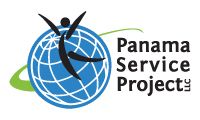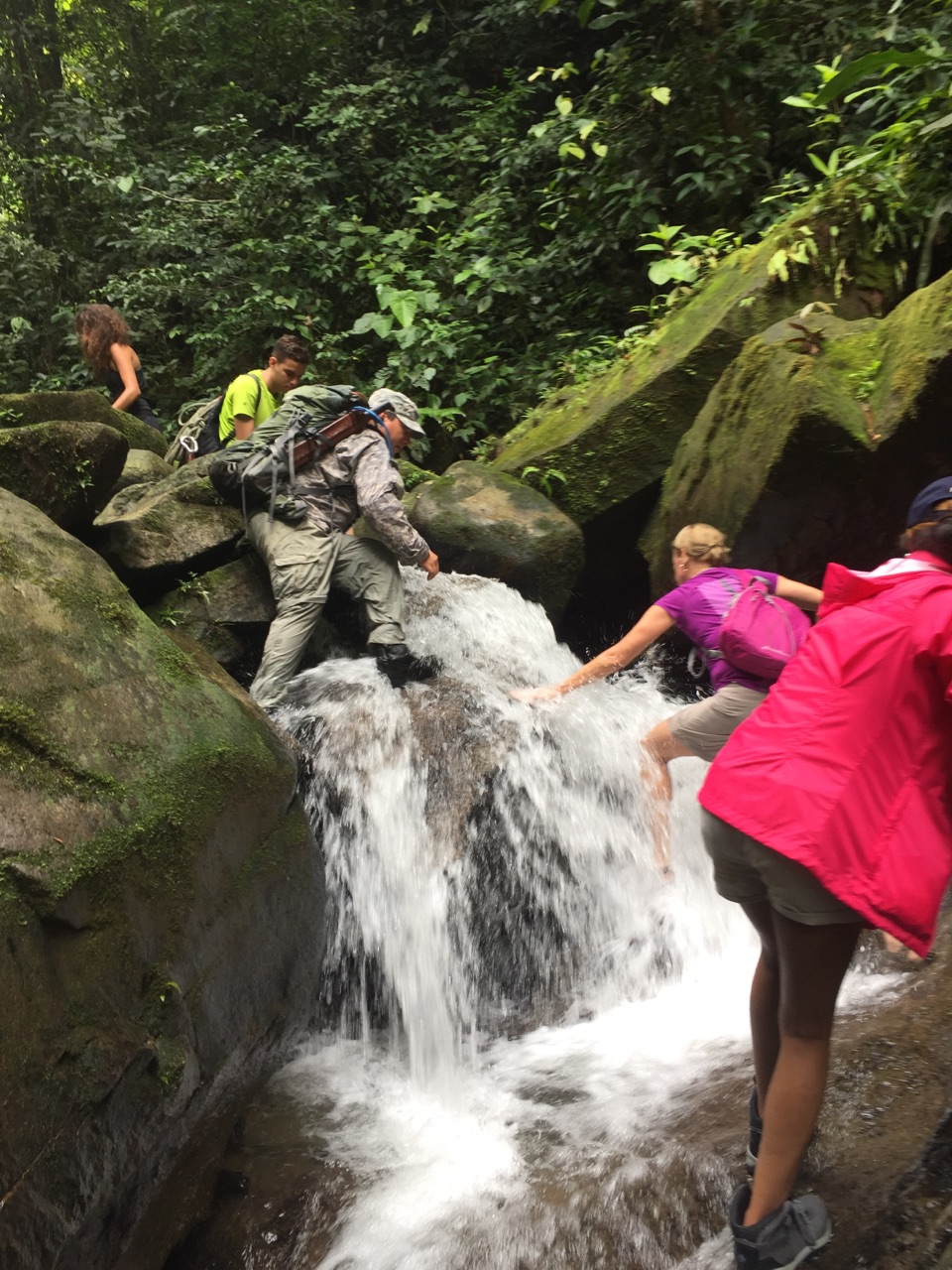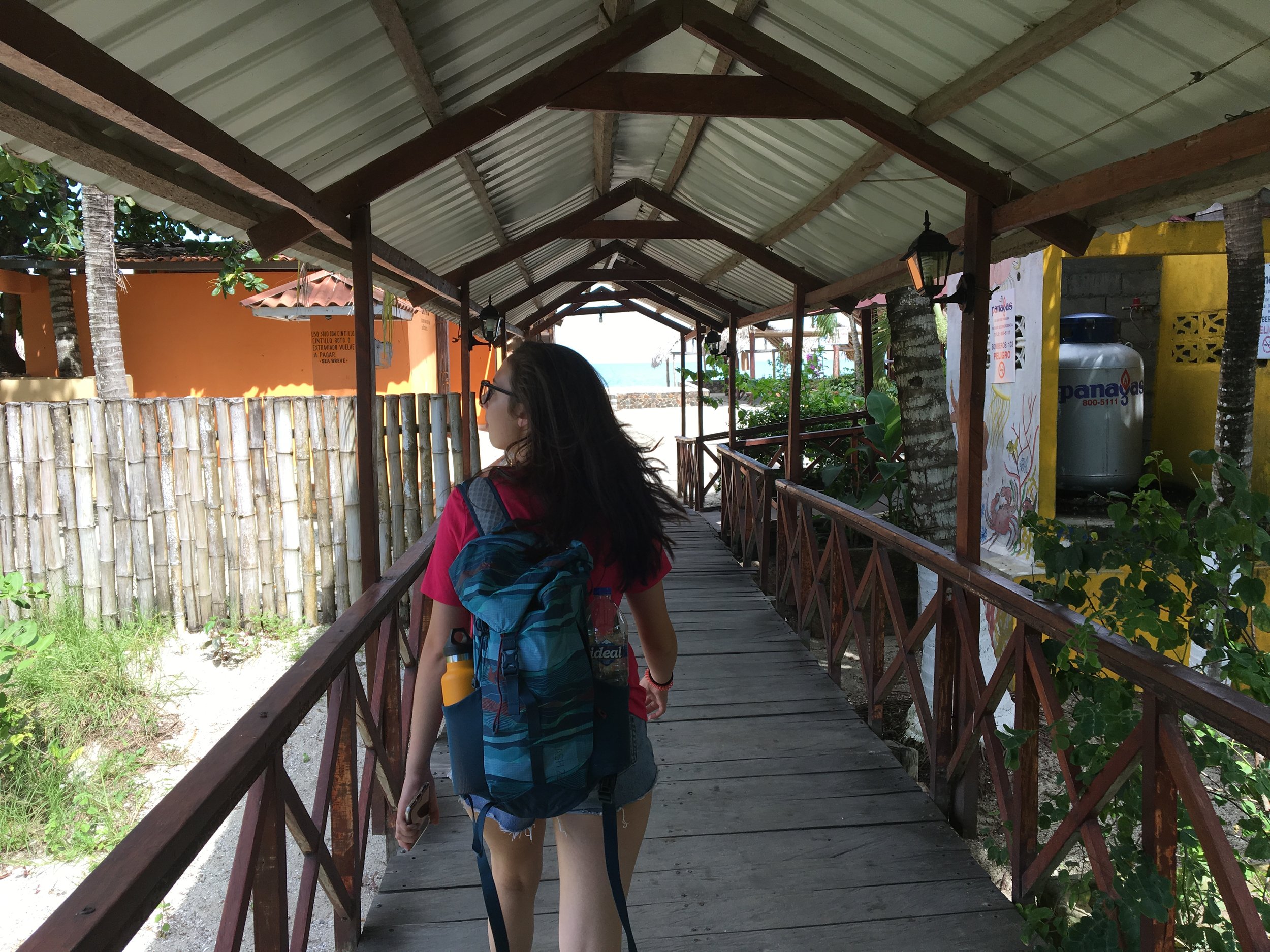Today we met Jesus...
We started off our day at Nutre Hogar. We played with the children as we waited for everyone to arrive so we could start our adventure for the day. It took an hour to arrive at our destination, which was a ranch called "Altos de Platanal", or High plateaux, which is located in the city of "Cerro Plata". There, we met a man named Roberto, or as he is better known, Padre Roberto, or Father Roberto. He greeted us in a building that was made all from things found in the forest. The roof was made from Royal Palm leaves, and the pillars and stairs all made from different types of various woods. There he explained to us his mission. Father Roberto does not only want to help the people, but to educate them so they can then also help themselves and others. Father spoke further on how it was possible to use land to be able sustain a person and many people, as long as you know how to.
After this, we went on a tour of his garden where we were greeted by 2 pools that were full of Tilapia. Further down the path, he talked about the plants in his garden, which ranged from plantains, coffee, limes, oranges, yucca, guanabana, papaya, and many plants that had multiple medicinal properties. After we passed through his garden, we went to the "Parque de Las Piedras" or Park of the rocks, which was a meditative place full of big rocks. From there we walked down a path that led back into the garden. Here we met Domingo. Domingo was the name of a donkey that lives on the farm. After we had all pet the donkey and talked about him, we continued on the path, towards the end of the path, where we saw a cage that had a few parrots. They were full of brilliant colors and were amazing to look at. From there, we were taken to a greenhouse where we saw pumpkin seeds. These seeds were on carpets to dry out. After this, Father showed us the all-organic fertilizer that they had made. They explained that it is so strong, that they need to mix it with water because if they just put it over the plants, that they would die. He then showed us his greenhouse were he had various types of plants. He explained to us how what each plant can help with or what their purpose was. At the end of the tour of his garden, we were met with fried plantain strips, a popular snack in Panama.
After our little snack, we each started to get into trucks to deliver supplies to the families that lived in the area. Because there were many of us, and only 3 pick-up trucks, many of us got to sit in the back of those trucks. For those that decided to sit in the back, it was a very bumpy road. The first house we approached had quite a large family. The grandparents tended to the children and the crops. Some children also helped tend the crops. They had their own little farm and more land on the other side of the river. As soon as we opened up the bag of supplies you could see the family's eyes glow; you could see how much appreciation they had for these supplies and how happy they were. We talked to the family and we said our goodbyes. The trip to the second house was not a long one as we drove down the street for only a few minutes. There is where we met the second family. We greeted them with the same friendly smile and they came out with the same glistening eyes that were similar to the first family. After giving them their supplies we went on our way to the next stop.
Our third stop was an agricultural school. This school was called "P. Pedro Hulsefosch". We learned that this place is a school that some of the children nearby attend on Saturday and learn about agricultural activities. At this location we learned what the fertilizer is made of and how it is put together. They begin by putting Californian worms in the manure of pigs, horses and cows. The worms are also eating and expelling their own waste in the solution. This product is then mixed with coffee beans and other ingredients to create the final product. We then walked down to the garden at the school which is also full of various plants such as yucca, pineapple, and cucumber. There were as many as 5,000 pineapples at this location. Father Roberto walked us down to see his greenhouse that he was starting to build. We also learned about the call of the people there, where they shout at each other and make different noises. He showed us this because he called his friend down to show us how to harvest yucca. Father's friend then took us to where a ripe yucca was located, and simply pulled up the plant. But because yucca is a root similar to potatoes, the man chopped off the roots of the yucca plants to be eaten later. After this, we returned to the truck. As these first three stops took some time, we returned to the ranch for lunch.
Our lunch was rice, salad, chicken, and beans. Once we finished our lunch, we went on a second round to deliver two more bags. The second round involved much more off-road driving than the first round. The way to the third, fourth and fifth houses was definitely something to experience. The third family met us nervously in front of their house as Father explained that we came with supplies to give them. They thanked us and we went on to the fourth house.
When we were approaching the fourth house, the house of Jesus, Father Roberto told us a story that goes as follows. He was on his way to deliver items to a family for Christmas, when a few moments later, a man on a horse stopped him. The man told Father that his wife was going to give birth. So Father then hurried to get a nun, who also happened to be a nurse. As they arrived, they were welcomed with a mom holding her newborn baby. Father Roberto was given the privilege to name the baby, and because the baby was born on Christmas day, Father named the newborn Jesus. The walk to the fourth house is when Father told us the story. As we walked into the property, we were greeted by a little pig. We continued walking and were greeted by Jesus's family. They gave the same thanks that the previous families gave. After talking for a little bit, we found out that Jesus missed school for the day. We asked why and found out that he had a foot fungus. So Father told Jesus's mother to make sure to wash it and keep it clean to avoid making it worse. After Father gave the advice, we returned to the truck to make the last stop of the trip.
The last house had as many kids as the previous houses, but many were in school when we arrived. As we made our way down, Father told us that the grandpa went blind for 1 month because of cataracts. In this month the grandma had to do almost everything. Though the grandpa was able to return to work after his surgery, now the grandpa is unable to work. Fortunately, there are more people to help.

































































